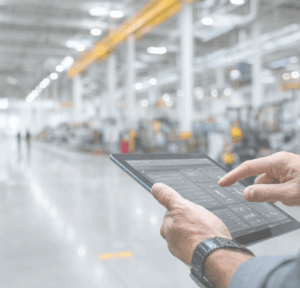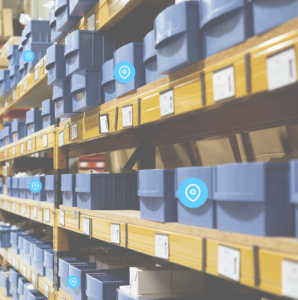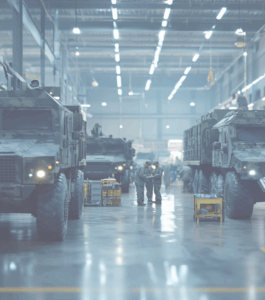How Asset Tracking and RTLS Technologies Optimize Processes – Here, You’ll Find Everything You Need to Know About RTLS.
RTLS systems play a crucial role in the automation and optimization of processes in Industry 4.0 by enabling the precise localization of mobile assets or objects such as machines, tools, transport vehicles, containers, or industrial goods. To efficiently manage complex operations in industrial environments, it is essential to continuously monitor the location and status of relevant objects.
Asset tracking – the continuous monitoring of physical resources and objects – enables companies to increase transparency in their processes, achieve more precise planning, and improve resource utilization. Real-Time Locating Systems (RTLS) provide the technological foundation for this. They combine tags, anchors, gateways, as well as network and software components to enable continuous and automated monitoring. RTLS systems make it possible to seamlessly track assets in real-time, optimize material availability, and prevent the loss of valuable resources.
In the following, we will examine what RTLS means, how these systems work, and their applications in the industry.
What does asset tracking and RTLS mean?
Asset tracking refers to the tracking and management of physical resources, such as machines, tools, vehicles, or materials, within a defined area. It provides companies the ability to monitor the location, condition, and availability of assets in real-time.
RTLS systems (Real-Time Location Systems) are technologies that capture real-time location data from various objects or people. These objects are typically located within a specific application area, such as industrial manufacturing or warehouses. To determine accurate data about the position of tagged objects, precise localization data is provided using sensors and a network infrastructure. This enables companies to manage their resources efficiently and optimize their processes.
How do RTLS systems work?
RTLS uses various radio technologies such as BLE, GPS, RFID, mesh networks, or UWB to determine the precise position of tools within a specific area. These systems enable continuous monitoring and provide valuable information to efficiently manage resources.
- Tags and sensors: Various objects are equipped with small tags that transmit signals. These can communicate via radio frequencies (RFID, BLE, AoA, UHF, IR, WAVE) or other standards such as Wirepas Mesh or Ultra-Wideband (UWB).
- Infrastructure: The data from the tags is transmitted via a receiver, such as gateways (BLE), locators (AoA), anchors (Mesh), or satellites (UWB).
- Software platform: The transmitted data is processed and visualized in a software platform. This platform typically consists of two components: the positioning engines, which calculate the exact position and, if necessary, convert it into other coordinate systems, and the hub, which distributes the data to other systems. Through a dashboard, users gain comprehensive insights into the current position, movement history, and condition of the assets.
Comparison of the most common RTLS technologies.
In the field of asset tracking and real-time location, there are various technologies that are suitable depending on the use case and requirements in industrial environments. Here is an overview of the most common tracking technologies and their respective advantages:
GPS (Global Positioning System)
GPS is an established satellite technology primarily used in Europe for location tracking over long distances. It enables asset tracking outdoors with an accuracy of up to a few meters. GPS is particularly suitable for applications that require global coverage, such as tracking vehicle fleets or containers outdoors. GPS faces limitations in enclosed spaces and densely built areas, as buildings can block the signal. Additionally, its energy consumption is relatively high, making it less suitable for battery-powered devices.
BLE (Bluetooth Low Energy)
BLE is a widely used radio technology optimized for communication over short distances. It requires very little energy, making it ideal for battery-powered tags that need to run for long periods without maintenance. BLE is particularly well-suited for use in areas such as logistics or environments where objects are tracked within relatively confined spaces. It is easy to implement and widely available. However, BLE has a lower range and accuracy in indoor environments with partitions or shelves compared to other technologies and requires a large number of gateways. Additionally, BLE can be error-prone in many working environments, as it communicates point-to-point, leading to more data loss compared to a mesh topology that works with fewer gateways.
AOA (Angle of Arrival)
AOA is an advanced technique used in conjunction with BLE to determine the exact position of a tag by capturing the angle at which the signal is received by multiple antennas. This technology is suitable for high-precision applications where accurate localization (within one meter) is required in a limited area, such as for the precise assignment of tools to a workstation in manufacturing.
RFID (Radio Frequency Identification)
RFID (Radio Frequency Identification) is one of the oldest and most commonly used technologies for asset tracking, utilizing tags available in three variants: passive, semi-passive, and active. Passive RFID tags derive their energy from the reader’s signal and have a limited range, making them particularly suitable for tracking large quantities of objects over very short distances, such as goods on pallets or in containers. Semi-passive RFID tags have their own power source for operating internal components, but they only actively transmit data when captured by a reader, allowing them to cover greater distances than passive tags without continuously transmitting. Active RFID tags have their own power supply and continuously emit signals, making them particularly suitable for real-time tracking of moving objects. RFID is ideal for tracking infrequently moved assets or for simultaneously capturing large quantities.
Wirepas Mesh
Wirepas Mesh is a flexible, wireless network designed for industrial applications where scalable and reliable communication over long distances is required. Unlike traditional point-to-point systems, devices in a mesh network can autonomously connect and forward data, allowing for greater range and redundancy. Wirepas Mesh is ideal for asset tracking in large, complex environments where a stable and cost-effective infrastructure with few gateways is needed.
UWB (Ultra Wide Band)
UWB is a highly precise technology primarily used for real-time asset tracking. It is characterized by high accuracy (often in the centimeter range) and very high update rates, making it particularly suitable for applications where precise positioning with low latency is required. UWB can be used in a variety of environments, from production halls to complex storage facilities.
How do RTLS systems find applications in industry?
RTLS systems offer a wide range of applications across various industrial sectors and play a key role in optimizing processes and resource management.
Manufacturing: In manufacturing, RTLS systems enable the precise tracking of machines and production tools, ensuring continuous material supply. Real-time localization helps make the right material available at the right time and place to avoid production interruptions. Additionally, the technology supports quality control by ensuring that materials remain at specific stations only for the intended duration. This leads to more efficient production and higher productivity.
Warehouse and logistics applications: In warehouse and logistics applications, RTLS ensures efficient inventory management and tracking of goods movements. By integrating RTLS technologies, companies can precisely determine the location of pallets, containers, and transport vehicles at any time. The system improves inventory accuracy and optimizes material flow. Reduced search times speed up processes, minimize errors, and simplify workflows.
Healthcare: Another major potential is seen in healthcare, especially in hospitals and nursing facilities. Here, RTLS enables the precise positioning of medical devices, beds, and even patients. This helps keep valuable resources, such as medical equipment, easily locatable, manage emergencies more efficiently, and improve the quality of care.
Benefits of RTLS systems for industry:
The implementation of RTLS brings numerous benefits. It helps companies increase their efficiency, optimize processes, and maintain competitiveness. Here are the key benefits at a glance:
Process optimization: The precise real-time localization of assets allows companies to adjust production schedules flexibly. This enables better utilization of equipment and a dynamic response to unforeseen events such as material shortages. The company minimizes production downtimes and boosts overall productivity.
Time savings through reduced search times: RTLS eliminates the time-consuming search for tools, machines, and materials. Production managers and employees can immediately determine the location of required assets and focus on value-adding activities.
Automated inventory management and bookings: RTLS systems capture inventory levels and material movements in real-time and transfer them directly into ERP systems like SAP. This reduces manual interventions, minimizes errors, and ensures an up-to-date inventory overview. Companies benefit from precise real-time data, which not only simplifies warehouse management but also enables informed value stream analysis and optimization.
Quality assurance and compliance: In industries with strict documentation requirements, such as the automotive or pharmaceutical industries, RTLS systems ensure seamless tracking of materials, components, and production processes. This not only simplifies compliance with regulatory requirements but also improves quality assurance.
Decision-making foundations for executives:
With the precise real-time data provided by RTLS systems, executives can make informed decisions. By analyzing movement and condition data, bottlenecks can be identified, optimization measures can be derived, and long-term strategies can be developed.

Successfully implementing Cavea RTLS systems.
Cavea offers specially developed hardware that combines various localization technologies such as Bluetooth, RFID, Angle of Arrival (AOA), and Wirepas Mesh in a single tag. This innovative integration allows the deployment of technologies to be tailored to the specific requirements of different application areas, ensuring an even better ROI.
The versatility of the tags ensures maximum scalability and makes it easy to efficiently automate a wide range of industrial environments. Whether it’s precise localization in manufacturing halls, comprehensive inventory management in warehouses, or tracking medical devices – our solution enables flexible and future-proof automation.
Another key advantage: Our hardware is fully omlox-compatible. This means it seamlessly integrates into the open, standardized infrastructure that defines the industry standard for real-time localization. Companies benefit from a forward-looking solution that is not only efficient and reliable, but also offers maximum flexibility to respond to changing requirements.
With Cavea RTLS systems, you get the ideal foundation to optimize processes, create transparency, and successfully pave the way for Industry 4.0.


